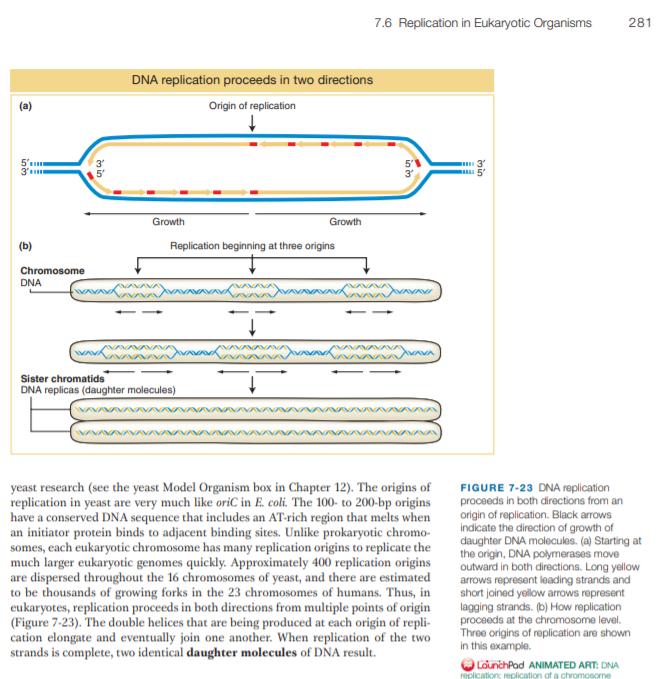7.6 Replication in Eukaryotic Organisms 281 DNA replication proceeds in two directions (a) Origin of replication 5' 3' Growth Growth (b) Replication beginning at three origins Chromosome DNA Sister chromatids DNA replicas (daughter molecules) yeast research (see the yeast Model Organism box in Chapter 12). The origins of replication in yeast are very much like oriC in E. coli. The 100- to 200-bp origins have a conserved DNA sequence that includes an AT-rich region that melts when an initiator protein binds to adjacent binding sites. Unlike prokaryotic chromo- somes, each eukaryotic chromosome has many replication origins to replicate the much larger eukaryotic genomes quickly. Approximately 400 replication origins are dispersed throughout the 16 chromosomes of yeast, and there are estimated to be thousands of growing forks in the 23 chromosomes of humans. Thus, in eukaryotes, replication proceeds in both directions from multiple points of origin (Figure 7-23). The double helices that are being produced at each origin of repli- cation elongate and eventually join one another. When replication of the two strands is complete, two identical daughter molecules of DÑA result. FIGURE 7-23 DNA replication proceeds in both directions from an origin of replication. Black arrows indicate the direction of growth of daughter DNA molecules. (a) Starting at the origin, DNA polymerases move outward in both directions. Long yellow arrows represent leading strands and short joined yellow arrows represent lagging strands. (b) How replication proceeds at the chromosome level. Three origins of replication are shown in this example. LounchPad ANIMATED ART: DNA replication replication of a chromosome nin in in n in
DNA and RNA
Deoxyribonucleic acid (DNA) is usually called the blueprint of life. Deoxyribose is a monosaccharide that has a key function in the synthesis of deoxyribonucleic acid. One less oxygen-containing hydroxyl group occurs in deoxyribose sugar. Nucleic acid, deoxyribonucleic acid, is one of the natural components. Deoxyribonucleic acid is a double-stranded molecule. Watson and Crick postulated the double-stranded model of the helix. A deoxyribonucleic acid is a molecular group that carries and transmits genetic information from parents to offspring. All eukaryotic and prokaryotic cells are involved.
DNA as the Genetic Material
DNA, or deoxyribonucleic acid, is a long polymeric nucleic acid molecule discovered in the late 1930s. It is a polymer; a long chain-like molecule made up of several monomers connected in a sequence. It possesses certain characteristics that qualify it as a genetic component. Certain organisms have different types of nucleic acids as their genetic material - DNA or RNA.
Genetics
The significant branch in science which involves the study of genes, gene variations, and the organism's heredity is known as genetics. It is also used to study the involvement of a gene or set of genes in the health of an individual and how it prevents several diseases in a human being. Thus, genetics also creates an understanding of various medical conditions.
DNA Replication
The mechanism by which deoxyribonucleic acid (DNA) is capable of producing an exact copy of its own is defined as DNA replication. The DNA molecules utilize a semiconservative method for replication.
In Figure 7-23(a), label all the leading and lagging
strands.

Trending now
This is a popular solution!
Step by step
Solved in 2 steps with 1 images







